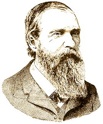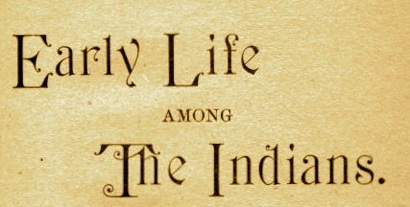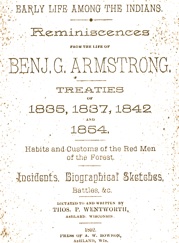Chief Buffalo and Benjamin Armstrong

‘This undertaking I begin, not without misgivings as to my ability to finish a well connected history of my recollections’
Passage from “Early Life Among the Indians: Reminiscences from the Life of Benj. G. Armstrong” on his thoughts about writing his memoirs:
“This undertaking I begin, not without misgivings as to my ability to finish a well connected history of my recollections. I kept no dates at any time, and must rely wholly upon my memory at seventy-one years of age. Those of my white associates in the early days, who are still living, are not within reach to assist me by rehearsals of former times. Those of the older Indians who could assist me, could I converse with them, have passed beyond the Great River, and the younger ones, of whom there are many not far distant, could not assist me in the most essential portions of the work. Therefore, without assistance and assuring the reader that dates will be essentially correct, and that a strict adherence to facts will be followed, and with the hope that a generous public will make due allowance for the lapse of years, I am, Your obedient servant, The Author.”
Sampling of the diversity of books and materials that have cited Benjamin Armstrong or memoirs:
“Reminiscences of Life Among the Chippewa,” was an extensive four-part excerpt of Benj. Armstrong’s memoirs published in Wisconsin Magazine of History in 1972 and 1973
“Chippewa Treaty Rights: The Reserved Rights of Wisconsin’s Chippewa Indians in Historical Perspective” by Ronald N. Satz (1991)
“Wild Rice and the Ojibway People” by Thomas Vennum Jr. (1988)
“La Pointe: Village Outpost on Madeline Island” by Hamilton Nelson Ross (1960)
“Ojibwe Journeys: Treaties, Sandy Lake and the Waabanong Run” by Charlie Otto Rasmussen (2003)
“The Chippewa: A History of the Great Lakes Woodland Tribe over Three Centuries” by Walker D.Wyman with Kurt Leichtle (1993)
“Bibliography of Ojibwe Resources Material” by the Minnesota Historical Society (1981)
“Life with the Ojibwe: A Northern Land” by Howard D. Paap (2001)
“Madeline Island & the Chequamegon Region” by John O. Holzhueter (1986)
The federal Seventh Circuit Court of Appeals case of Lac Courte Oreilles Band of Lake Superior Chippewa Indians v. Voigt (1982)
“Visitor’s Guide to the Apostle Islands National Lakeshore” by Dave Strzok (1988)
“Oak Island” brochure by the National Park Service and the Apostle Islands National Lakeshore (present)
“People and Places: A Human History of the Apostle Islands” by Jane C. Busch, Ph.D. (2008)
“They Would Not Be Moved: The Chippewa Treaty of 1854,” by Edmund J. Danziger Jr. in Minnesota History (Spring 1973).
“The Chippewa: A History of the Great Lakes Woodland Tribe over Three Centuries” by Walker D. Wyman with Kurt Leichtle (1993)
“History, Tradition and Adventure in the Chippewa Valley” by William W. Bartlett (1929)
Notes about ‘Early Life’
The complete title of the book is “Early Life Among the Indians — Reminiscences from the Life of Benj. G. Armstrong. Treaties of 1835, 1837, 1842 and 1854. Habits and Customs of the Red Men of the Forest. Incidents, Biographical Sketches, Battles. Dictated to and written by Thos. P. Wentworth.” Published by the Press of A.W. Bowron, Ashland, Wis., 1892.
An Antiquarian Booksellers Association of America posting regarding a first edition of book that was up for sale for $750 says: “Uncommon on the commercial market; only one copy at auction in the past 40 years. Recollections of a pioneer, hunter, and fur trader among the Indians of Wisconsin and Minnesota dating from 1835 onward, providing a valuable source of the history of the fur trade in the region.”
Google and others publish digitized versions
To read “Early Life Among the Indians: Reminiscences from the Life of Benj. G. Armstrong,” click here for Google Books. Or you can click here for the Wisconsin Historical Society version or click here for Archive.org’s version.
Excerpts reprinted in the 1970s
The Wisconsin Magazine of History in 1972 and 1973 printed four lengthy excerpts titled “Reminiscences of Life Among the Chippewa,” calling them “a record of people and events in a little-known aspect of Wisconsin’s total heritage.” Part 1 declared: How Armstrong “came to spend most of his adult life in companionship with Indians makes for a rousing tale ... He appeared to have been well aware of the normal inability of an aged man to recall names and dates with precision. In his preface he disarms the reader with his candor in this respect, at the same time maintaining that the events he describes are correct in their essential details. Careful consultation of the appropriate sources proves the validity of his contention ... Printed on cheap newsprint, Armstrong’s book was not designed to withstand the ravages of time. In fact, the Society’s copy, kept in the relative immunity of its library’s rare book room, crumbled while being xeroxed for editing. Its fragility, together with the probable scarcity and utility of such copies as may remain in home or other libraries, played a major role in the decision to republish at least a portion of the memoirs before they become irretrievably lost.” Click here for Part 1
The Voigt federal court decision
The contentious 1982 federal case of Lac Courte Oreilles Band of Lake Superior Chippewa Indians v. Voigt brought Armstrong’s book to the public eye. The U.S. Court of Appeals for the Seventh Circuit cited Armstrong’s memoirs in the deciding that the tribe retained off-reservation hunting and fishing rights. Click here or here to read the entire court decision. Read the Great Lakes Indian Fish and Wildlife Commission’s opinion on the significance of the Voigt decision by clicking here.
The court’s reliance on the Armstrong memoirs — which a decade earlier had been partially reprinted in a year-long series of excerpts by the Wisconsin Historical Society’s magazine — brought a backlash by anti-treaty and hunting groups. For example, former Minnesota Vikings head coach and anti-treaty activist Bud Grant later attacked the decision and Armstrong in a letter sent to the Minneapolis Star Tribune, writing in part: “In the Wisconsin case, the only historical commentary came from a version of events from the late 1800s recorded by Benjamin Armstrong (who was married to a tribal leader's daughter).”
The book “Chippewa Treaty Rights: The Reserved Rights of Wisconsin’s Chippewa Indians in Historical Perspective” by professor Ronald N. Satz provides insights into another attempt to discredit Armstrong’s memoirs. The professor points out what seem to be inconsistencies in the objections to the memoirs made by James A. Clifton. Clifton was a critic of off-reservation rights who was unhappy with the legal precedent the case set.
Professor Satz wrote that Clinton in a 1988 Associated Press news article “attacked recent court rulings restoring Chippewa hunting, fishing, and gathering rights in ceded territory, claiming the rulings relied heavily on Armstrong's memoirs. The Wisconsin news media paid considerable attention to Clifton’s assertions because of possible implications on court decisions relating to rights reserved by the Chippewas ... Clifton’s contention that Armstrong’s claims about Chippewa reserved rights cannot be independently corroborated is erroneous and, as will be noted, is clearly refuted by eyewitnesses to the treaty proceedings.”
In an article published on anti-treaty-rights Web site, Clifton appears to dip into conspiracy theory territory. He maintains that both the publication of Armstrong’s memoirs in the 1890s and the extensive republication of them in the Wisconsin Magazine of History — eight decades later — in the 1970s may have been engineered to help the Chippewa’s claim to off-reservation hunting and fishing.




Benjamin G. Armstrong’s 1892 reminiscences:
Capturing history and making history
The book “Early Life Among the Indians: Reminiscences from the Life of Benj. G. Armstrong” has been called “a record of people and events in a little-known aspect of Wisconsin’s total heritage.” The book had long sat on the shelves of university libraries and other institutions where researchers would find it and cite it in their works. But the memoirs were virtually unknown to the public at large even in the Lake Superior region.
The Wisconsin Historical Society in the 1970s worried this piece of history literally would crumble away and printed a four-part excerpt in its magazine. It noted, “Armstrong’s book was not designed to withstand the ravages of time. In fact, the Society’s copy ... crumbled while being xeroxed for editing. Its fragility, together with the probable scarcity and utility of such copies as may remain in home or other libraries, played a major role in the decision to republish at least a portion of the memoirs before they become irretrievably lost.”
The 1892 book today is finding a new life, thanks to the Internet. Google Books and other Internet sites have digitized to Armstrong’s memoirs to preserve it for generations to come. His work not only documented life in the woodlands frontier of the Lake Superior region in the 1800s, it helped create history in the next century when a federal court cited the memoirs in a ground-breaking decision on tribal rights and treaty protections.

Above are two images from the original printing of Benjamin G. Armstrong’s 1892 book. The picture of the book with the words “Early History” on the cover is a reprint in the collections of the Ashland Historical Museum in Wisconsin. The cover page reads: “The 2008 reprinting of this book was sponsored by the Ashland High School Class of 1957 in memory of their classmate Edith C. Olsen Mahnke, 1939 - 2008, great-great granddaughter of Benjamin G. Armstrong.”
This site is published by a member of the Minnesota Chippewa Tribe. Click here for more information
